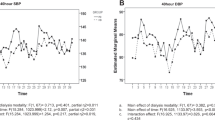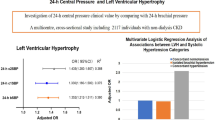Abstract
Prior studies have associated automated peritoneal dialysis (APD) with less effective volume and blood pressure (BP) control as compared with continuous ambulatory peritoneal dialysis (CAPD). Our study aimed to compare the volume status, ambulatory BP profile and severity of arterial stiffness between patients treated with CAPD versus APD. In a case-control design, 28 CAPD patients were matched in 1:1 ratio with 28 controls receiving APD for age, gender and diabetic status. Body composition was assessed with the method of bioimpendence spectroscopy. Twenty-four hours ambulatory BP monitoring with the Mobil-O-Graph device (IEM, Germany) was performed to determine peripheral and central hemodynamic parameters, heart rate-adjusted augmentation index (AIx75) and pulse wave velocity (PWV). Standardized office BP, antihypertensive medication use and extracellular-to-total body water ratio did not differ between CAPD and APD groups. Twenty-four hours brachial systolic BP (129.0 ± 17.3 vs. 128.1 ± 14.2 mmHg, P = 0.83) and 24-h aortic systolic BP (116.9 ± 16.4 vs. 116.4 ± 11.6 mmHg, P = 0.87) were similar in patients treated with CAPD versus APD. Similarly, there was no significant difference between PD modalities in severity of arterial stiffness, as assessed with 24-h AIx75 (24.8 ± 8.9 vs. 22.5 ± 9.1, P = 0.36) and 24-h PWV (9.1 ± 2.4 vs. 8.8 ± 2.1 m/s, P = 0.61). The present study suggests that there is no difference in peripheral and central hemodynamic parameters as well as in the severity of arterial stiffness between CAPD and APD. However, these observations should be interpreted within the context of clinical characteristics of patients included in this case-control study. The comparative effectiveness of these 2 PD modalities warrants further investigation in larger longitudinal studies.
This is a preview of subscription content, access via your institution
Access options
Subscribe to this journal
Receive 12 digital issues and online access to articles
$119.00 per year
only $9.92 per issue
Buy this article
- Purchase on Springer Link
- Instant access to full article PDF
Prices may be subject to local taxes which are calculated during checkout


Similar content being viewed by others
References
Bieber SD, Burkart J, Golper TA, Teitelbaum I, Mehrotra R. Comparative outcomes between continuous ambulatory and automated peritoneal dialysis: a narrative review. Am J Kidney Dis. 2014;63:1027–37.
Liakopoulos V, Dombros N. Patient selection for automated peritoneal dialysis: for whom, when? Perit Dial Int. 2009;29 Suppl 2:S102–7.
Jain AK, Blake P, Cordy P, Garg AX. Global trends in rates of peritoneal dialysis. J Am Soc Nephrol. 2012;23:533–44.
Borrelli S, La Milia V, De Nicola L, Cabiddu G, Russo R, Provenzano M, et al. Sodium removal by peritoneal dialysis: a systematic review and meta-analysis. J Nephrol. 2019;32:231–9.
Davison SN, Jhangri GS, Jindal K, Pannu N. Comparison of volume overload with cycler-assisted versus continuous ambulatory peritoneal dialysis. Clin J Am Soc Nephrol. 2009;4:1044–50.
Ortega O, Gallar P, Carreno A, Gutierrez M, Rodriguez I, Oliet A, et al. Peritoneal sodium mass removal in continuous ambulatory peritoneal dialysis and automated peritoneal dialysis: influence on blood pressure control. Am J Nephrol. 2001;21:189–93.
Rodriguez-Carmona A. Sodium removal in patients undergoing capd and automated peritoneal dialysis. Perit Dial Int. 2002;22:705–13.
Rodriguez-Carmona A, Perez-Fontan M, Garca-Naveiro R, Villaverde P, Peteiro J. Compared time profiles of ultrafiltration, sodium removal, and renal function in incident capd and automated peritoneal dialysis patients. Am J Kidney Dis. 2004;44:132–45.
Atas N, Erten Y, Okyay GU, Inal S, Topal S, Onec K, et al. Left ventricular hypertrophy and blood pressure control in automated and continuous ambulatory peritoneal dialysis patients. Ther Apher Dial. 2014;18:297–304.
Cnossen TT, Konings CJ, Fagel WJ, van der Sande FM, van Geel K, Leunissen KM, et al. Fluid state and blood pressure control: no differences between APD and CAPD. ASAIO J. 2012;58:132–6.
Jang JS, Kwon SK, Kim HY. Comparison of blood pressure control and left ventricular hypertrophy in patients on continuous ambulatory peritoneal dialysis (CAPD) and automated peritoneal dialysis (APD). Electrolyte Blood Press. 2011;9:16–22.
Vaios V, Georgianos PI, Vareta G, Dounousi E, Dimitriadis C, Eleftheriadis T, et al. Clinic and home blood pressure monitoring for the detection of ambulatory hypertension among patients on peritoneal dialysis. Hypertension. 2019;74:998–1004.
Wabel P, Chamney P, Moissl U, Jirka T. Importance of whole-body bioimpedance spectroscopy for the management of fluid balance. Blood Purif. 2009;27:75–80.
O'brien E, Mee F, Atkins N, Thomas M. Evaluation of three devices for self-measurement of blood pressure according to the revised british hypertension society protocol: the Omron Hem-705cp, Philips Hp5332, and Nissei Ds-175. Blood Press Monit. 1996;1:55–61.
Dou Y, Liu L, Cheng X, Cao L, Zuo L. Comparison of bioimpedance methods for estimating total body water and intracellular water changes during hemodialysis. Nephrol Dial Transplant. 2011;26:3319–24.
Williams B, Mancia G, Spiering W, Agabiti RE, Azizi M, Burnier M. et al. 2018 Esc/Esh guidelines for the management of arterial hypertension: The task force for the management of arterial hypertension of the European Society of Cardiology and the European Society of Hypertension. J Hypertens. 2018;36:1953–2041.
Pm Franssen, Bp Imholz. Evaluation of the Mobil-O-Graph new generation ABPM device using the ESH criteria. Blood Press Monit. 2010;15:229–31.
Parati G, Stergiou G, O'brien E, Asmar R, Beilin L, Bilo G, et al. European Society of Hypertension practice guidelines for ambulatory blood pressure monitoring. J Hypertens. 2014;32:1359–66.
Laurent S, Cockcroft J, Van Bortel L, Boutouyrie P, Giannattasio C, Hayoz D, et al. Expert consensus document on arterial stiffness: methodological issues and clinical applications. Eur Heart J. 2006;27:2588–605.
Sarafidis PA, Georgianos PI, Karpetas A, Bikos A, Korelidou L, Tersi M, et al. Evaluation of a novel brachial cuff-based oscillometric method for estimating central systolic pressure in hemodialysis patients. Am J Nephrol. 2014;40:242–50.
Vaios V, Georgianos PI, Pikilidou MI, Eleftheriadis T, Zarogiannis S, Papagianni A, et al. Accuracy of a newly-introduced oscillometric device for the estimation of arterial stiffness indices in patients on peritoneal dialysis: a preliminary validation study. Adv Perit Dial. 2018;34:24–31.
Hametner B, Wassertheurer S, Kropf J, Mayer C, Eber B, Weber T. Oscillometric estimation of aortic pulse wave velocity: comparison with intra-aortic catheter measurements. Blood Press Monit. 2013;18:173–6.
Davenport A, Willicombe M. Comparison of fluid status in patients treated by different modalities of peritoneal dialysis using multi-frequency bioimpedance. Int J Artif Organs. 2009;32:779–86.
Georgianos PI, Pikilidou MI, Liakopoulos V, Balaskas EV, Zebekakis PE. Arterial stiffness in end-stage renal disease-pathogenesis, clinical epidemiology, and therapeutic potentials. Hypertens Res. 2018;41:309–19.
Vlachopoulos C, Aznaouridis K, Stefanadis C. Prediction of cardiovascular events and all-cause mortality with arterial stiffness: a systematic review and meta-analysis. J Am Coll Cardiol. 2010;55:1318–27.
Bao W, Wang F, Tang W. Aortic-brachial stiffness mismatch and mortality in peritoneal dialysis patients. Kidney Blood Press Res. 2019;44:123–32.
Blacher J, Guerin AP, Pannier B, Marchais SJ, Safar ME, London GM. Impact of aortic stiffness on survival in end-stage renal disease. Circulation. 1999;99:2434–9.
Georgianos PI, Sarafidis PA, Lasaridis AN. Arterial stiffness: a novel cardiovascular risk factor in kidney disease patients. Curr Vasc Pharmacol. 2015;13:229–38.
Badve SV, Hawley CM, Mcdonald SP, Mudge DW, Rosman JB, Brown FG, et al. Automated And Continuous Ambulatory Peritoneal Dialysis Have Similar Outcomes. Kidney Int. 2008;73:480–8.
Michels WM, Verduijn M, Boeschoten EW, Dekker FW, Krediet RT. Similar survival on automated peritoneal dialysis and continuous ambulatory peritoneal dialysis in a large prospective cohort. Clin J Am Soc Nephrol. 2009;4:943–9.
Author information
Authors and Affiliations
Corresponding author
Ethics declarations
Conflict of interest
The authors declare no competing interests.
Additional information
Publisher’s note Springer Nature remains neutral with regard to jurisdictional claims in published maps and institutional affiliations.
Rights and permissions
About this article
Cite this article
Vaios, V., Georgianos, P.I., Vareta, G. et al. A comparative analysis of ambulatory BP profile and arterial stiffness between CAPD and APD. J Hum Hypertens 36, 254–262 (2022). https://doi.org/10.1038/s41371-021-00516-5
Received:
Revised:
Accepted:
Published:
Issue Date:
DOI: https://doi.org/10.1038/s41371-021-00516-5



